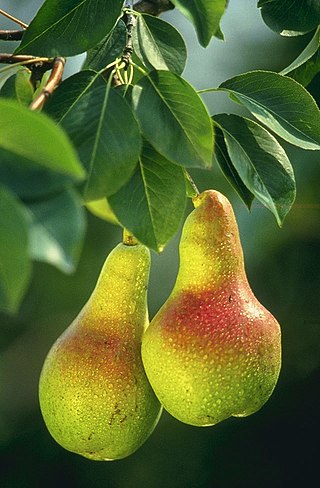
Pears are fruits produced and consumed around the world, growing on a tree and harvested in late summer into mid-autumn. The pear tree and shrub are a species of genus Pyrus, in the family Rosaceae, bearing the pomaceous fruit of the same name. Several species of pears are valued for their edible fruit and juices, while others are cultivated as trees.
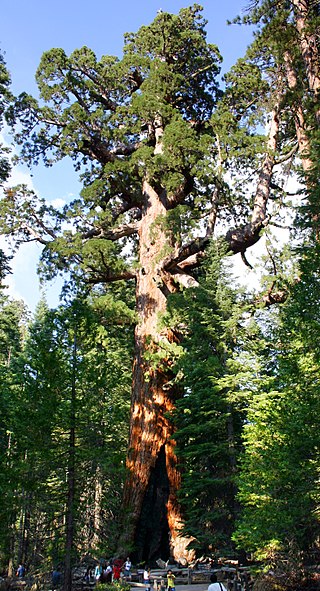
Sequoiadendron giganteum, also known as the giant sequoia, giant redwood or Sierra redwood is a coniferous tree, classified in the family Cupressaceae in the subfamily Sequoioideae. Giant sequoia specimens are the most massive trees on Earth. They occur naturally only in groves on the western slopes of the Sierra Nevada mountain range of California.

Breadfruit is a species of flowering tree in the mulberry and jackfruit family (Moraceae) believed to be a domesticated descendant of Artocarpus camansi originating in New Guinea, the Maluku Islands, and the Philippines. It was initially spread to Oceania via the Austronesian expansion. It was further spread to other tropical regions of the world during the Colonial Era. British and French navigators introduced a few Polynesian seedless varieties to Caribbean islands during the late 18th century. Today it is grown in some 90 countries throughout South and Southeast Asia, the Pacific Ocean, the Caribbean, Central America and Africa. Its name is derived from the texture of the moderately ripe fruit when cooked, similar to freshly baked bread and having a potato-like flavor.

Maclura pomifera, commonly known as the Osage orange, is a small deciduous tree or large shrub, native to the south-central United States. It typically grows about 8 to 15 metres (30–50 ft) tall. The distinctive fruit, a multiple fruit, is roughly spherical, bumpy, 8 to 15 centimetres (3–6 in) in diameter, and turns bright yellow-green in the fall. The fruits secrete a sticky white latex when cut or damaged. Despite the name "Osage orange", it is not related to the orange. It is a member of the mulberry family, Moraceae. Due to its latex secretions and woody pulp, the fruit is typically not eaten by humans and rarely by foraging animals. Ecologists Daniel H. Janzen and Paul S. Martin proposed in 1982 that the fruit of this species might be an example of what has come to be called an evolutionary anachronism—that is, a fruit coevolved with a large animal seed dispersal partner that is now extinct. This hypothesis is controversial.

The cashew tree is a tropical evergreen tree native to South America in the genus Anacardium that produces the cashew seed and the cashew apple accessory fruit. The tree can grow as tall as 14 metres, but the dwarf cultivars, growing up to 6 m (20 ft), prove more profitable, with earlier maturity and greater yields. The cashew seed is commonly considered a snack nut eaten on its own, used in recipes, or processed into cashew cheese or cashew butter. Like the tree, the nut is often simply called a cashew. Cashew allergies are triggered by the proteins found in tree nuts, and cooking often does not remove or change these proteins.

The chestnuts are the deciduous trees and shrubs in the genus Castanea, in the beech family Fagaceae. They are native to temperate regions of the Northern Hemisphere.

Anacardium, the cashews, are a genus of flowering plants in the family Anacardiaceae, native to tropical regions of the Americas. The best known species is Anacardium occidentale, which is commercially cultivated for its cashew nuts and cashew apples.
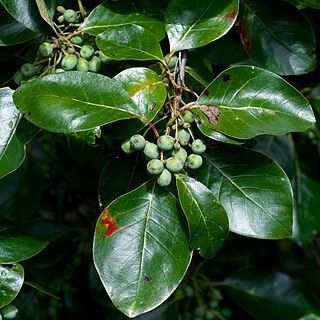
Nyssa sylvatica, commonly known as tupelo, black tupelo, black gum or sour gum, is a medium-sized deciduous tree native to eastern North America from the coastal Northeastern United States and southern Ontario south to central Florida and eastern Texas, as well as Mexico.

Malus is a genus of about 30–55 species of small deciduous trees or shrubs in the family Rosaceae, including the domesticated orchard apple, crab apples and wild apples.

Castanea sativa, the sweet chestnut, Spanish chestnut or just chestnut, is a species of tree in the family Fagaceae, native to Southern Europe and Asia Minor, and widely cultivated throughout the temperate world. A substantial, long-lived deciduous tree, it produces an edible seed, the chestnut, which has been used in cooking since ancient times.

Serenoa repens, commonly known as saw palmetto, is a small palm, growing to a maximum height around 200–300 cm (6.6–9.8 ft).

The açaí palm, Euterpe oleracea, is a species of palm tree (Arecaceae) cultivated for its fruit, hearts of palm, leaves, and trunk wood. Global demand for the fruit has expanded rapidly in the 21st century, and the tree is cultivated for that purpose primarily.

Syzygium cumini, commonly known as Malabar plum, Java plum, black plum, jamun, jaman, jambul, or jambolan, is an evergreen tropical tree in the flowering plant family Myrtaceae, and favored for its fruit, timber, and ornamental value. It is native to the Indian subcontinent and Southeast Asia, including Myanmar, Sri Lanka, Bangladesh and the Andaman Islands. It can reach heights of up to 30 metres (98 ft) and can live more than 100 years. A rapidly growing plant, it is considered an invasive species in many world regions.

Arbutus unedo is an evergreen shrub or small tree in the family Ericaceae, native to the Mediterranean Basin and Western Europe. The tree is well known for its fruits, the arbutus berry, which bear some resemblance to the strawberry, hence the common name strawberry tree. However, it is not closely related to true strawberries of the genus Fragaria.

Terminalia elliptica is a species of Terminalia native to southern and southeast Asia in India, Nepal, Bangladesh, Myanmar, Thailand, Laos, Cambodia, and Vietnam. It is a prominent part of both dry and moist deciduous forests in southern India up to 1000 m.
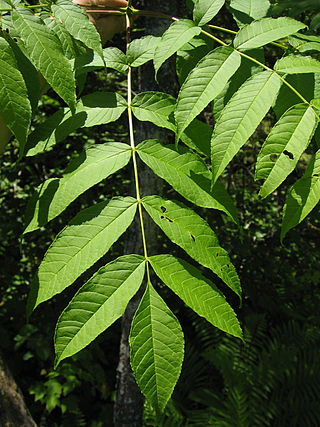
Fraxinus nigra, the black ash, is a species of ash native to much of eastern Canada and the northeastern United States, from western Newfoundland west to southeastern Manitoba, and south to Illinois and northern Virginia. Formerly abundant, as of 2014 the species is threatened with near total extirpation throughout its range, as a result of infestation by a parasitic insect known as the emerald ash borer.

Bursera simaruba, commonly known as gumbo-limbo, copperwood, chaca, West Indian birch, naked Indian, and turpentine tree, is a tree species in the family Burseraceae, native to the Neotropics, from South Florida to Mexico and the Caribbean to Brazil, Nicaragua, and Venezuela. Bursera simaruba is prevalent in the Petenes mangroves ecoregion of the Yucatán, where it is a subdominant plant species to the mangroves. In the United States, specimens may be found in the Gulf of Mexico along the western coast of Florida.

The jostaberry is a complex-cross fruit bush in the genus Ribes, involving three original species, the blackcurrant R. nigrum, the North American coastal black gooseberry R. divaricatum, and the European gooseberry R. uva-crispa. It is similar to Ribes × culverwellii, the jochelbeere, which is descended from just two of these species, R. nigrum and R. uva-crispa.
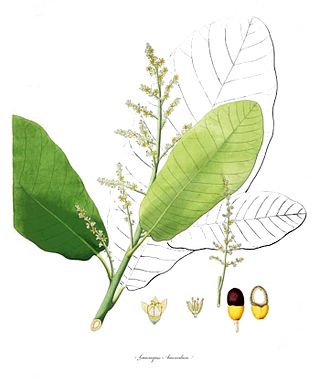
Semecarpus anacardium, commonly known as the marking nut tree, Malacca bean tree, marany nut, oriental cashew, phobi nut tree and varnish tree, is a native of India, found in the outer Himalayas to the Coromandel Coast. It is closely related to the cashew.

Anacardic acids are phenolic lipids, chemical compounds found in the shell of the cashew nut. An acid form of urushiol, they also cause an allergic skin rash on contact, known as urushiol-induced contact dermatitis. Anacardic acid is a yellow liquid. It is partially miscible with ethanol and ether, but nearly immiscible with water. Chemically, anacardic acid is a mixture of several closely related organic compounds. Each consists of a salicylic acid substituted with an alkyl chain that has 15 or 17 carbon atoms. The alkyl group may be saturated or unsaturated; anacardic acid is a mixture of saturated and unsaturated molecules. The exact mixture depends on the species of the plant. The 15-carbon unsaturated side chain compound found in the cashew plant is lethal to Gram-positive bacteria.



















